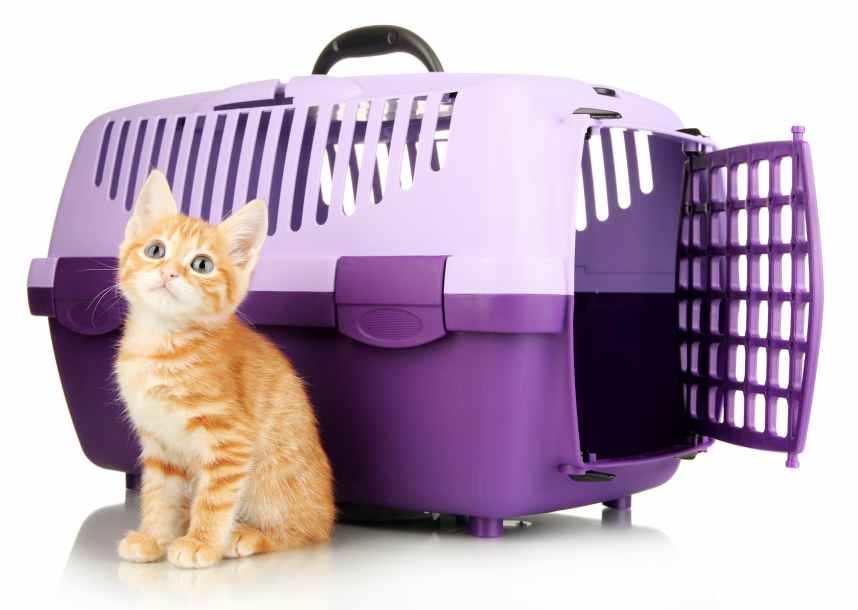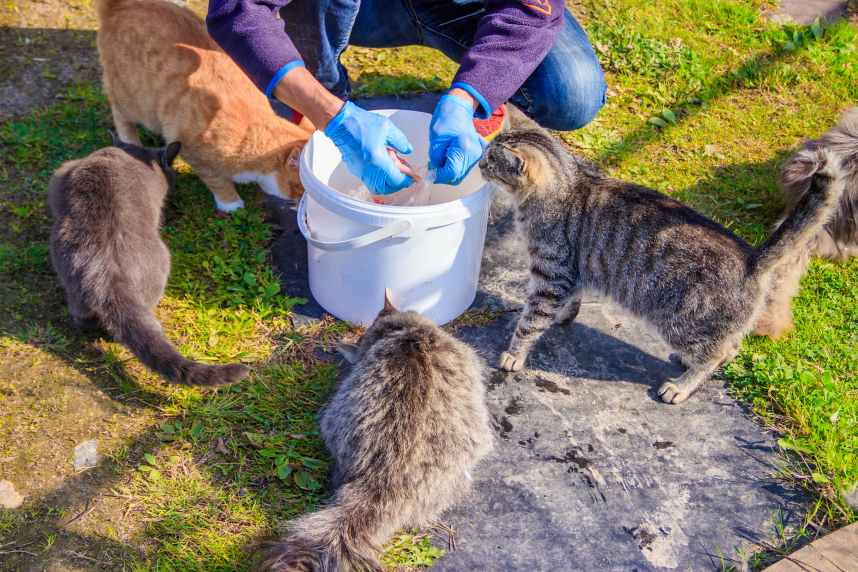
Moving House with a Cat: A Comprehensive Guide
Moving house can be very stressful for cats. These creatures have learnt the ins and outs of your home and are comfortable with it in its entirety.
When a cat is moved to a new home, they have to spend time learning their new surroundings, including territories of other cats and smells and sounds they may not have previously been used to.
While this is stressful for the cat, the fear of losing your beloved cat in your new area is just as stressful for you.
There are plenty of simple strategies you can employ to make moving far more manageable and far less stressful. So, here is the comprehensive guide to moving house with a cat:
Table of Contents
Before Moving
Follow these steps to ensure you’re cat is safe and ready, before your moving day:
Pheromone Use
Unknown to many, cats create pheromones when they feel secure and mark their surroundings, their home.
You may have seen your cat do this. They rub their face on objects around the home, releasing this pheromone.
You can buy plug-in diffusers; they release this pheromone into the air; therefore making cats feel more at home, helping them feel calmer and safer.
The top 10 pheromone diffusers for cats can be found at PetLifeToday. Top tip: Plug these in 24 hours before you move into your new home so that the pheromones are already in the air when your cat arrives.
Maintain Set Routines
If you’ve been on holiday and packed when your cat is around; you’ll know that they tend to become quite inquisitive of your bags.
When packing to move home, it’s imperative that you keep to a rigid schedule, ensuring that your cat still feels a sense of security and control within its home environment.
Create a Safe Zone
During the last couple of weeks of packing, there will be boxes everywhere. To make this easier for your cat, slowly move their food, water and toys to a quiet room within the house.
Do this slowly, and they will gradually adapt to the new positioning of everything, allowing them to feel more secure and comfortable, away from all the packing and loud noises that come with it.
Put the Travel Box Out
Cats aren’t as easy to persuade as dogs. They tend to be able to put one and one together when it comes to particular objects.
This is especially true when it comes to the travel box/cage you use to bring them to the vets in. They will associate the box with the vets and, typically, will not go into this box voluntarily.
To help your cat get used to the travel box, leave it in the safe zone for a considerable period of time and allow the cat to become accustomed to it and enter voluntarily.
Travelling With Your Cat
Once in the travel box, most cats don’t deal well with being in a moving vehicle and seeing the surroundings flash by through the window.
Some common tricks are to cover the box up, feed them at certain times beforehand (if they get sick), and even the use different types of carrier.
The best advice to give is to speak with your vets and see what they bets recommend for your cat.
Bringing Cats Into the UK from Abroad
There are usually plenty of hoops to jump through when bringing cats from one country to another; however, the UK has three simple criteria your cat must fulfil. Your cat must:
- have a microchip
- have a pet-passport or a third-country veterinary certificate
- vaccinated against rabies, and have a blood test if from an ‘unlisted country.’
Fulfil this criteria, and your cat will have no problem entering the UK.
Taking cats Overseas from the UK
Taking your cat to other countries requires you to fulfil different criteria depending on the country you are moving to.
Moving to the EU could become more complicated if we leave without a deal, with the government advising to start the processing of moving animals at least four months before you travel
Register with a Local Vet
It’s recommended to register with a vet, in your new area, as soon as possible.
Hopefully you won’t need to use them anytime soon; however your cat will be in an entirely new environment, meaning that accidents and injuries are more likely to occur.
Prepare for the worst, but hope for the best.
Updating Microchip Details
Your cats’ microchip contains the address of which your cat lives. Be sure to change this when / before you move.
If your cat escapes through an open door while moving everything into the house, it’s possible he/she will run off and get lost in this new environment.
Is Your New House Cat Safe?
You are probably more aware than anyone else that you can’t control what a cat does. They go out when they want and explore where ever they like.
One thing you can control is the safety within the home and the immediate surroundings of your house.
If you’re aware that the road outside is a main road, try and keep them in the back garden for the time being. Are there any dangerous or slippery areas they could fall and harm themselves? Deal with these before your cat has an accident.
Moving Day
This is the all-important day. There will likely be a lot going on, a lot of open doors, new smells, new sounds. All of these can be somewhat overwhelming for a cat. Here are a few things you can do to make their lives that little bit more comfortable.
Transporting Your Cat
Transporting cats isn’t an easy task. Many don’t like cars in the first place, making long-distance travelling stressful for all involved.
First thing’s first, make sure your cat is safe and secure the carrier in the car in case of a quick stop. Either strap the carrier in with a seatbelt or wedge it in place and keep a close eye on it at all times.
Throughout the journey, make sure your cat is well watered and well-fed (unless they are prone to travel sickness).
In all, do your best to look after your cat and realise that this is stressful for both of you; ensuring the cat is stress-free and as comfortable as can be whenever possible.
Thoroughly Clean Your New House
As has been mentioned previously, cats heavily rely on scent for understanding and learning their environments and other cat territories.
If your new home used to be home to cats, then it is highly recommended to thoroughly clean the house before bringing your cat into the fold.
You needn’t have to worry about the top of doors, shelves that are out of reach and the like. Focusing on anything at ‘cat height’ will be enough to make them feel comfortable in their new home.
Consider a Temporary Cattery
With so many open doors on the move-in day, it may be best to leave your cat in a cattery on the day.
If possible, drive to your new home and drop your cat off in a local cattery which you’ve booked in advance.
When you’re fully moved in and everyone is relaxed and settled, pick your cat up from the cattery and introduce him/her to the new home.
With everyone calm and relaxed, your cat will feel safer and will have time to slowly accustom itself with the new environment, including smells and sounds.
Keep Your Cat in Their Safe Zone
If the cattery is not an option, then designate another ‘safe zone’ in your new home and keep your cat in this area with all the necessities to make it comfortable.
This includes things such as food, water, litter tray, toys and treats. Not only does this keep them out of the way and comfortable in their new environment; it keeps them safe.
If they are in a dedicated room for them alone, they are away from the loud noises, removal men and new smells. This means they are less likely to bolt out of an open door if they feel scared or insecure.
Maintain Previous Routines
This is a challenging step to adhere to. With everything that’s going on, try and keep the schedule for your cat the same as it was before.
Feed them at normal times and try and dedicate some one-on-one time with your cat to make them feel less stressed.
Deviating from their routine slightly is bound to happen but stick to as much as possible to reduce the amount of stress your cat will go through.
Post Moving Day
You’ve moved in; everything has been unpacked. The last thing left is to keep a close eye on your cat for the coming months.
Be Prepared For Little Accidents
With different smells everywhere your cat goes, moving house with a cat will create opportunities for a few accidents along the way. Your cat may get in a fight with your new curtains; maybe they’ll end up having an emergency toilet by the door, getting confused by the smells.
If they attack the curtains, then tell them off slightly; however, in the event of a toilet accident, show them the correct place they should be going. This will help them learn for the future.
If they are indoor cats, then use the same litter you used at your old home, as this will be a familiar smell for them to understand. Hopefully, this will be enough to convince them to go to the toilet in the same smelling place that they always have.
Slowly Increase Your Cat’s Territory
Just like when your cat was first introduced to your home, slowly open up the house to them. For the first week or so, keep them isolated to a couple of rooms.
Slowly expand your cat’s territory within the home, making sure windows and doors to other rooms are shut. Your cat may even be ten years old, but this entirely new environment is exceedingly overwhelming, so make sure to take everything slow and don’t rush anything.
Preventing Cats from Returning To Their Old Home
Moving away a long distance is better for a cat, than merely moving a few streets away.
This is because your cat will recognise these smells around you as familiar and could go in search of your old home. This is incredibly problematic and a fear many pet owners have.
Make sure you give them a lot of attention in their new home and always feed them on time and ensure they have enough water, treats and toys throughout the day. This will make them less likely to head towards your old home.
When you move homes, make sure to give the new owners your details and ask them to contact you if your cat suddenly appears at the back door of their house.
Going Outdoors
This is the greatest step in moving house with a cat. They love to be outside and will want to go out more and more as time goes on in your new home.
Keep your cat inside for at least three weeks, allowing them to learn the scents of your new home and leave some of their own with their pheromones.
When you let them out for the first time, do it before they have been fed so they will come back shortly for food.
When you open the door, join your cat outside and walk around the garden with them, while keeping a few metres distance between the two of you.
Let them out for short periods at first, and slowly build up their confidence outside until they can come and go as they please.
Ready to Start Moving House with your Cat?
Hopefully, the above article has calmed some of your fears about moving house with your cat.
GoodMove are here to help you move safely and stress-free. We have over 35 years’ experience handling removals throughout the UK and Europe.
Our customer-driven approach to removals has earned us critical acclaim. We believe our written testimonials, which can be found on Reference Line, are our testament to the service we deliver.
We also offer flexible self-storage options to our customers either as part of a tailor-made removals package or as a standalone service.
To find our how GoodMove’s removals service can work for you don’t hesitate to contact us on the number listed above or use the quick quote form.
Get a Quote
Recent Posts
- Your 4-Week Moving Countdown: Avoiding the Last-Minute Rush 26th Jun 2025
- GoodMove’s Stress-Free Guide to Moving House This Summer 18th Jun 2025
- Moving & Packing Tips You Need To Know When Moving House 12th Jun 2025
- Moving to Spain: Your Ultimate Guide for 2025 05th Jun 2025
- 9 Best Essex Coastal Towns to Live or Visit 29th May 2025
- 8 Reasons to Start Living in Sittingbourne in 2025 21th May 2025
- Living in Chigwell – Essex Golden Triangle Area Guide 15th May 2025
- 7 Great Reasons to Start Living in Herne Bay 08th May 2025
- 9 Great Reasons to Start Living in Faversham 30th Apr 2025
- Living in Buckhurst Hill – Essex Golden Triangle Area Guide 24th Apr 2025
- Living in Colchester – 15 Reasons to Move to Essex 16th Apr 2025
- Moving to Australia – 24 Must Know Facts 10th Apr 2025
- 13 Best Villages to Live in Suffolk 02th Apr 2025
- How to Select the Best Removals Company in Colchester 26th Mar 2025
- Living in Clacton on Sea – 7 Reasons to Move to the Essex Coast 19th Mar 2025
- The Definitive Guide To Home Removal Surveys And How To Get An Accurate Quote 13th Mar 2025
- 11 Prettiest Villages to Live in Essex 06th Mar 2025
- First-Time Movers’ Guide: Essential Tips and Tricks for a Successful Relocation 26th Feb 2025
- Living in Southend on Sea – A Guide to Life on the Essex Coast 20th Feb 2025
- Living in Rochester: Your Comprehensive Guide 12th Feb 2025









